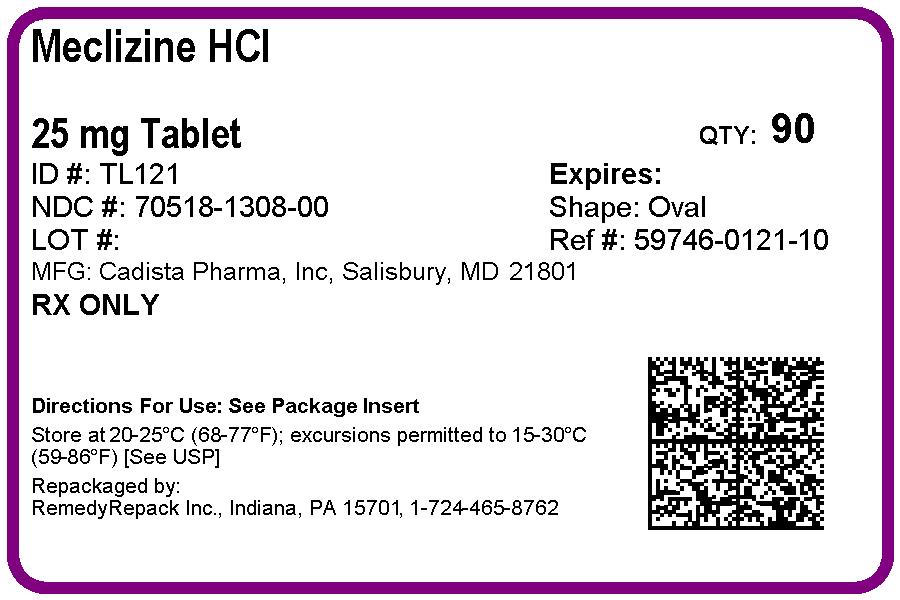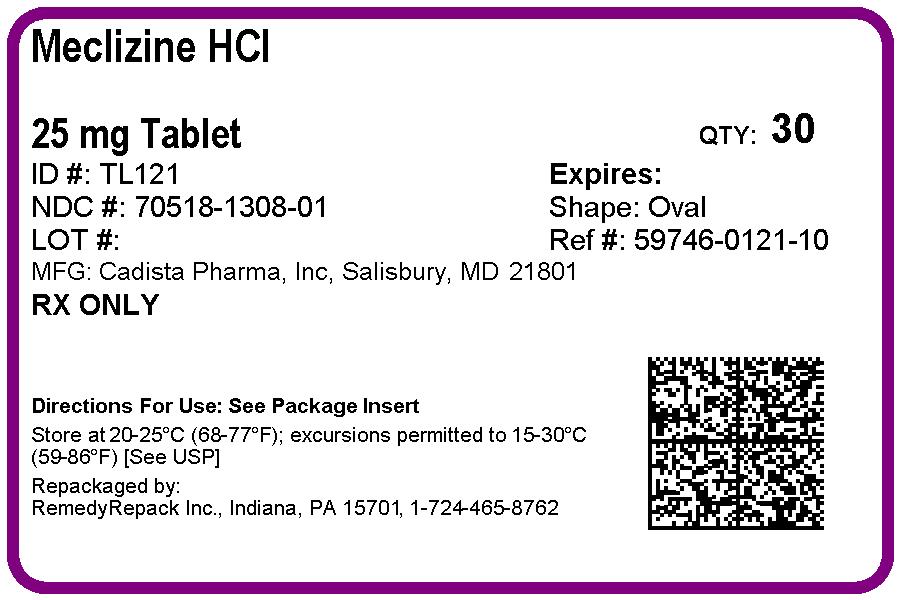MECLIZINE HYDROCHLORIDE- meclizine hydrocloride tablet
MECLIZINE HYDROCHLORIDE by
Drug Labeling and Warnings
MECLIZINE HYDROCHLORIDE by is a Prescription medication manufactured, distributed, or labeled by REMEDYREPACK INC.. Drug facts, warnings, and ingredients follow.
Drug Details [pdf]
-
DESCRIPTION
Meclizine HCl, USP an oral antiemetic, is a white or slightly yellowish, crystalline powder. It has the following structural formula:
Chemically, Meclizine HCl is 1-( p-chloro-α-phenylbenzyl)-4-( m-methylbenzyl) piperazine dihydrochloride monohydrate.
Meclizine hydrochloride tablets, USP are available in two different strengths: 12.5 mg and 25 mg. In addition each tablet contains the following inactive ingredients: Colloidal Silicon Dioxide, Croscarmellose Sodium, Lactose Monohydrate, Magnesium Stearate, Microcrystalline Cellulose. Also, Meclizine hydrochloride tablets USP, 12.5 mg contains FD&C Blue #1 Aluminum Lake (11-13%) and Meclizine hydrochloride tablets USP, 25 mg contains D&C Yellow #10 Aluminum Lake (15-20%).
Each meclizine HCl 12.5 mg tablet contains 12.5 mg of meclizine dihydrochloride equivalent to 10.53 mg of meclizine free base.
Each meclizine HCl 25 mg tablet contains 25 mg of meclizine dihydrochloride equivalent to 21.07 mg of meclizine free base.
-
CLINICAL PHARMACOLOGY
Meclizine hydrochloride is an antihistamine that shows marked protective activity against nebulized histamine and lethal doses of intravenously injected histamine in guinea pigs. It has a marked effect in blocking the vasodepressor response to histamine, but only a slight blocking action against acetylcholine. Its activity is relatively weak in inhibiting the spasmogenic action of histamine on isolated guinea pig ileum.
Pharmacokinetics
The available pharmacokinetic information for meclizine following oral administration has been summarized from published literature.Absorption
Meclizine is absorbed after oral administration with maximum plasma concentrations reaching at a median T max value of 3 hours post-dose (range: 1.5 to 6 hours) for the tablet dosage form.Metabolism
The metabolic fate of meclizine in humans is unknown. In an in vitro metabolic study using human hepatic microsome and recombinant CYP enzyme, CYP2D6 was found to be the dominant enzyme for metabolism of meclizine.The genetic polymorphism of CYP2D6 that results in extensive-, poor-, intermediate- and ultra-rapid metabolizer phenotypes could contribute to large inter-individual variability in meclizine exposure.
- INDICATIONS AND USAGE
- CONTRAINDICATIONS
-
WARNINGS
Since drowsiness may, on occasion, occur with use of this drug, patients should be warned of this possibility and cautioned against driving a car or operating dangerous machinery.
Patients should avoid alcoholic beverages while taking this drug.
Due to its potential anticholinergic action, this drug should be used with caution in patients with asthma, glaucoma, or enlargement of the prostate gland.
-
PRECAUTIONS
Pediatric Use
Clinical studies establishing safety and effectiveness in children have not been done; therefore, usage is not recommended in children under 12 years of age.
Pregnancy
Teratogenic Effects. Pregnancy Category B.
Reproduction studies in rats have shown cleft palates at 25-50 times the human dose. Epidemiological studies in pregnant women, however, do not indicate that meclizine increases the risk of abnormalities when administered during pregnancy. Despite the animal findings, it would appear that the possibility of fetal harm is remote. Nevertheless, meclizine, or any other medication, should be used during pregnancy only if clearly necessary.
Nursing Mothers
It is not known whether this drug is excreted in human milk. Because many drugs are excreted in human milk, caution should be exercised when meclizine is administered to a nursing woman.Hepatic Impairment
The effect of hepatic impairment on the pharmacokinetics of meclizine has not been evaluated. As meclizine undergoes metabolism, hepatic impairment may result in increased systemic exposure of the drug. Treatment with meclizine should be administered with caution in patients with hepatic impairment.Renal Impairment
The effect of renal impairment on the pharmacokinetics of meclizine has not been evaluated. Due to a potential for drug/metabolite accumulation, meclizine should be administered with caution in patients with renal impairment and in the elderly as renal function generally declines with age.Drug Interactions
There may be increased CNS depression when meclizine is administered concurrently with other CNS depressants, including alcohol, tranquilizers, and sedatives. ( see WARNINGS).Based on in-vitro evaluation, meclizine is metabolized by CYP2D6. Therefore there is a possibility for a drug interaction between meclizine and CYP2D6 inhibitors.
- ADVERSE REACTIONS
- DOSAGE AND ADMINISTRATION
-
HOW SUPPLIED
Meclizine hydrochloride tablets, USP are available in the following strengths and package sizes:
12.5 mg (Blue, oval shaped tablets, debossed with “TL 122” with score on one side and plain on the other side.)
Bottles of 100 NDC: 59746-122-06
Bottles of 1000 NDC: 59746-122-1025 mg (Yellow, oval shaped tablets, debossed with “TL 121” with score on one side and plain on the other side.)
Bottles of 100 NDC: 59746-121-06
Bottles of 1000 NDC: 59746-121-10Store at 20 to 25°C (68 to 77°F) [See USP Controlled Room Temperature].
Dispense in a tight, light-resistant container (USP).
Keep this and all medication out of the reach of children.
Manufactured By:
Jubilant Cadista Pharmaceuticals Inc.
Salisbury, MD 21801, USARevised 01/2019
-
PRINCIPAL DISPLAY PANEL
DRUG: MECLIZINE HYDROCHLORIDE
GENERIC: Meclizine Hydrocloride
DOSAGE: TABLET
ADMINSTRATION: ORAL
NDC: 70518-1308-00
NDC: 70518-1308-01
NDC: 70518-1308-02
COLOR: yellow
SHAPE: OVAL
SCORE: Two even pieces
SIZE: 13 mm
IMPRINT: TL121
PACKAGING: 90 in 1 BOTTLE PLASTIC
PACKAGING: 30 in 1 BOTTLE PLASTIC
PACKAGING: 60 in 1 BOTTLE PLASTIC
ACTIVE INGREDIENT(S):
- Meclizine Hydrochloride 25mg in 1
INACTIVE INGREDIENT(S):
- Aluminum Oxide
- Cellulose, Microcrystalline
- D&c Yellow No. 10
- Magnesium Stearate
- Croscarmellose Sodium
- Lactose Monohydrate
- Silicon Dioxide



-
INGREDIENTS AND APPEARANCE
MECLIZINE HYDROCHLORIDE
meclizine hydrocloride tabletProduct Information Product Type HUMAN PRESCRIPTION DRUG Item Code (Source) NDC: 70518-1308(NDC:59746-121) Route of Administration ORAL Active Ingredient/Active Moiety Ingredient Name Basis of Strength Strength MECLIZINE HYDROCHLORIDE (UNII: HDP7W44CIO) (MECLIZINE - UNII:3L5TQ84570) MECLIZINE HYDROCHLORIDE 25 mg Inactive Ingredients Ingredient Name Strength SILICON DIOXIDE (UNII: ETJ7Z6XBU4) CROSCARMELLOSE SODIUM (UNII: M28OL1HH48) LACTOSE MONOHYDRATE (UNII: EWQ57Q8I5X) MAGNESIUM STEARATE (UNII: 70097M6I30) CELLULOSE, MICROCRYSTALLINE (UNII: OP1R32D61U) D&C YELLOW NO. 10 (UNII: 35SW5USQ3G) ALUMINUM OXIDE (UNII: LMI26O6933) Product Characteristics Color yellow Score 2 pieces Shape OVAL Size 13mm Flavor Imprint Code TL121 Contains Packaging # Item Code Package Description Marketing Start Date Marketing End Date 1 NDC: 70518-1308-0 90 in 1 BOTTLE, PLASTIC; Type 0: Not a Combination Product 08/17/2018 2 NDC: 70518-1308-1 30 in 1 BOTTLE, PLASTIC; Type 0: Not a Combination Product 08/21/2018 3 NDC: 70518-1308-2 60 in 1 BOTTLE, PLASTIC; Type 0: Not a Combination Product 01/02/2019 Marketing Information Marketing Category Application Number or Monograph Citation Marketing Start Date Marketing End Date ANDA ANDA040659 08/17/2018 Labeler - REMEDYREPACK INC. (829572556)
© 2025 FDA.report
This site is not affiliated with or endorsed by the FDA.